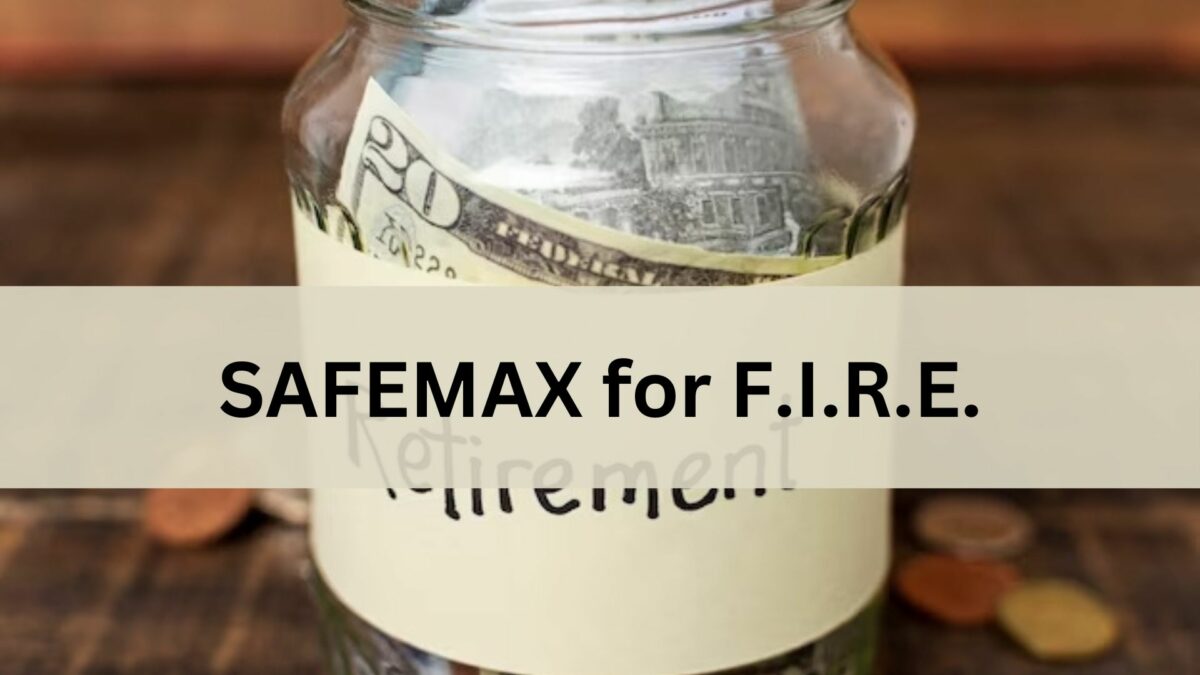I intend to live forever. So far, so good.
–Steven Wright
My wife and I semi-retired at the end of 2019. Well, she retired fully and I still serve on a few boards. Given that we were in our mid-40s, I consider us to have been a part of the FIRE movement (Financially Independent Retire Early), or, as I would prefer to name us, PIRE (Passive Income Retire Early).
Historically, financial planners have made their recommendations on how much you needed to save up and then be able to withdraw based on a 30 year retirement time window. The amount that you could withdraw was called SAFEMAX, and, historically, was 4%, based on research by William Bengen and then followed up by Cooley, Hubbard, and Walz in a study commonly called the Trinity Study.
Bengen’s original research was published in 1994. At that time, full retirement age for Social Security was 65 years old. In 1994, the Social Security Administration expected males to live for another 15.28 years and for females to live for another 19.03 years. So, a 30 year time window was very reasonable to plan for in retirement. Interestingly, while Bengen was predominantly focused on the 30 year retirement window, he did show research that 3% was a safe withdrawal rate for an asset allocation of 50% stocks and 50% 5 year Treasury bonds.
Given that the Social Security Administration expects me to live, on average, 35.1 more years and my wife to live another 40.2 years, and that Bengen’s research, based on 1992 returns, means that at our retirement, we were missing 27 years of data, or 30% of the market data since the S&P 500 was tracked starting in 1928, it would be wise for us to sharpen our pencils on the evaluation of how much we could spend in retirement.
To determine how much we could safely withdraw in retirement, I utilized the Bengen and Trinity frameworks reflecting our approach to retirement.
- We withdraw that year’s expenses at the beginning of the year. For example, if we assume the historical 4% safe withdrawal rate with a $1,000,000 portfolio, at the beginning of retirement, then we withdraw $40,000 on January 1, leaving us with a portfolio of $960,000.
- The remaining portfolio remains invested. The baseline allocation was 50% stocks and 50% corporate bonds (see Wade Pfau’s evaluation of why corporate bonds were preferred to government bonds in this line of research and my interview with Wade Pfau about whether or not you even need bonds in retirement). So, if, in the first year of retirement, the S&P 500 returned 10% and the corporate bond index returned 5%, the portfolio value would be $1,032,000 at the end of year 1.
- The next year’s spending withdrawal is based on the previous year’s inflation. If in year 1 of retirement, inflation was 3%, then projected spending for year 2 would be $41,200, and that amount is withdrawn at the beginning of year 2, leaving the investable portfolio at $990,800.
I then looked at historical returns of the S&P 500, corporate bonds, and inflation rates to project what would happen to us had we retired each year starting in 1928, a process called aftcasting (you can also see why aftcasting isn’t a perfect planning methodology).
I then looked at what the maximum amount I could withdraw each year was without running out of money, ranging from 1.1% to 10%, in increments of 0.1%, based on the initial portfolio amount. After all, generally speaking, your spending doesn’t vary much year over year, as long as you don’t get on the hedonic treadmill and experience lifestyle inflation. People who want to retire are solving for one of two variables: how much can you spend based on how much you’ve saved up at the time you retire, or determining how much you should have saved to retire based on your spending.
Based on my calculations, incorporating data from 1928 through 2019, this was the maximum amount we could expect to withdraw and, historically, not run out of money for the following retirement timeframes:
- 30 year retirement: 3.7%
- 40 year retirement: 3.4%
- 50 year retirement: 3.2%
However, as Billy Mays famously said, but wait, there’s more!
Bengen, in his study, showed different asset allocations: 0% stocks/100% bonds, 25% stocks/75% bonds, 50% stocks/50% bonds, 75% stocks/25% bonds, and 100% stocks/0% bonds. His conclusion was:
It is appropriate to advise the client to accept a stock allocation as close to 75% as possible, and in no cases, less than 50%.
The reasoning for a higher stock allocation was you need to account for inflation in your investments, and having too high of an allocation in bonds means that your portfolio can’t earn enough to keep up with the amount that you withdraw to sustain your lifestyle in retirement.
Bengen’s advice is a pretty rough set of guidelines. Somewhere between 50% and 75% doesn’t give you a good target to aim for when you need to rebalance your portfolio. Plus, what if you want to retire for 50 years? Have the additional 27 years since Bengen’s study changed anything?
I then solved to maximize the safe withdrawal rate for each retirement scenario (which, by the way, took my computer 30 seconds less than FOREVER to calculate) and calculated the following:
- 30 year retirement
- Optimal asset allocation: Between 70-97% stocks, between 3-30% bonds
- SAFEMAX: 3.9%
- 40 year retirement
- Optimal asset allocation: Between 89-95% stocks, between 6-11% bonds
- SAFEMAX: 3.7%
- 50 year retirement
- Optimal asset allocation: Between 81-100% stocks, Between 0-19% bonds
- SAFEMAX: 3.5%
This is still a rough swipe at safe withdrawal rates for people who are interested in the FIRE (or PIRE) movement or who, like we have, recently achieved early retirement.
But isn’t SAFEMAX 4%?

I think there are a couple of differences between my findings and Mr. Bengen’s findings.
First, there are some cohorts that would have hit their 30 year mark after Bengen’s work, such as the 1966 cohort.
Second, I calculated my “SAFEMAX” slightly differently than Bengen, taking a conservative withdrawal method of withdrawing the spending accounting for the previous year’s inflation (since it’s impossible to look into the crystal ball and know what next year’s inflation will be). Opinions vary wildly on how much to keep in cash in retirement, as this Bogleheads forum discussion about cash in retirement shows. Regardless, using this approach, growth years get hindered because not as much money is in the account at the beginning of the year.
Thirdly, in his research, Mr. Bengen did advise advisors to advise their clients (say that five times fast) to try to be as close to 75% stock allocation as possible.
I was a little surprised at how aggressive investing should be for longer time periods of retirement. This is also because the withdrawal rate has decreased. The less one taps into a portfolio, the more aggressive it can be.
How do rental properties factor into this evaluation?

Clearly, I’m not including rental properties in a SAFEMAX calculation.
However, we treat our rental properties like a juiced up bond portfolio.
The average corporate bond return is 5.1%.
Assuming that you go by the BiggerPockets 2% and 50% rules, then your “bond” portfolio of rental real estate should significantly outperform the corporate bond market with a lower standard deviation.
That is what happens with our portfolio, and when we have a property whose market value rises towards the 5.1% return rate, we rebalance our real estate portfolio by selling the property and purchasing one with a greater return rate on the market value of the property.
Time to rebalance your portfolio and get that asset allocation right if you’re planning on being a part of the FIRE movement.
Author Profile
- John Davis is a nationally recognized expert on credit reporting, credit scoring, and identity theft. He has written four books about his expertise in the field and has been featured extensively in numerous media outlets such as The Wall Street Journal, The Washington Post, CNN, CBS News, CNBC, Fox Business, and many more. With over 20 years of experience helping consumers understand their credit and identity protection rights, John is passionate about empowering people to take control of their finances. He works with financial institutions to develop consumer-friendly policies that promote financial literacy and responsible borrowing habits.
Latest entries
 Low Income GrantsSeptember 25, 2023How to Get a Free Government Phone: A Step-by-Step Guide
Low Income GrantsSeptember 25, 2023How to Get a Free Government Phone: A Step-by-Step Guide Low Income GrantsSeptember 25, 2023Dental Charities That Help With Dental Costs
Low Income GrantsSeptember 25, 2023Dental Charities That Help With Dental Costs Low Income GrantsSeptember 25, 2023Low-Cost Hearing Aids for Seniors: A Comprehensive Guide
Low Income GrantsSeptember 25, 2023Low-Cost Hearing Aids for Seniors: A Comprehensive Guide Low Income GrantsSeptember 25, 2023Second Chance Apartments that Accept Evictions: A Comprehensive Guide
Low Income GrantsSeptember 25, 2023Second Chance Apartments that Accept Evictions: A Comprehensive Guide

